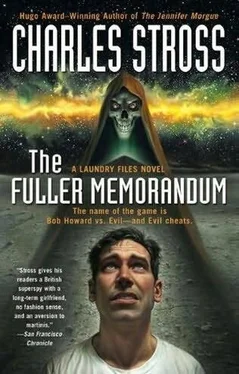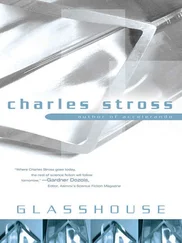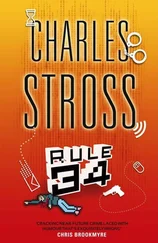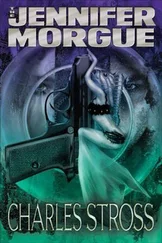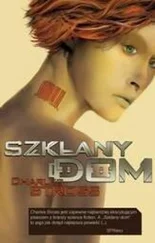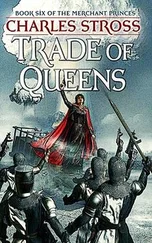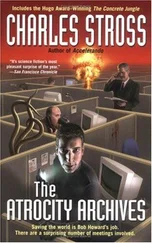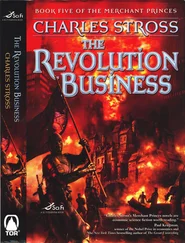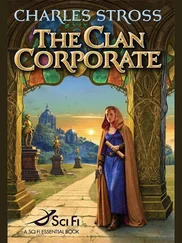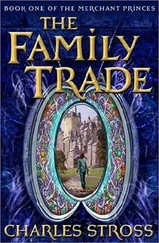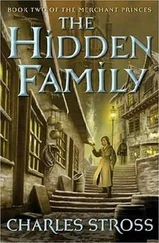During the nineteenth and early twentieth centuries, the scholars of night systematized and studied the occult with all the zeal Victorian taxonomists could bring to bear. There was a lot of rubbish written; Helena Blavatsky, bless her little cotton socks, muddied the waters in an immensely useful way, as did Annie Besant, and Krishnamurti, and a host of others.
And then there were those who came too damned close to the truth: if H. P. Lovecraft hadn’t died of intestinal cancer in 1937 something would have had to have been done about him, if you’ll pardon my subjunctive. (And it would have been messy, very messy-if old HPL was around today he’d be the kind of blogging and email junkie who’s in everybody’s RSS feed like some kind of giant mutant gossip squid.)
Then there were those who were sitting on top of the truth, if they’d had but the wits to see it-Dennis Wheatley, for example, worked down the hall in Deception Planning at SOE and regularly did lunch with a couple of staff officers who worked with Alan Turing-the man himself, not the anonymous code-named genius currently doing whatever it is they do in the secure wing at the Funny Farm. Luckily Wheatley wouldn’t have known a real paranormal excursion if it bit him on the arse. (In fact, looking back to the dusty manila files, I’m not entirely sure that Dennis Wheatley’s publisher wasn’t on the Deception Planning payroll after the war, if you follow my drift.)
But I digress.
It was to our great advantage during the cold war that the commies were always terrible at dealing with the supernatural.
For starters, having an ideology that explicitly denies the existence of an invisible sky daddy is a bit of a handicap when it comes to assimilating the idea of nightmarish immortal aliens from elsewhere in the multiverse, given that the NIAs in question have historically been identified as gods (subtype: elder). For seconds, blame Trofim Lysenko for corrupting their science faculty’s ability to cope with new findings that contradicted received political doctrine. For thirds, blame the Politburo, which, in the 1950s, looked at the embryonic IT industry, thought “tools of capitalist profit-mongers,” and denounced computer science as un-Communist.
Proximate results: they got into orbit using hand calculators, but completely dropped the ball on anything that required complexity theory, automated theorem proving, or sacrificial goats.
But that was then, and this is now, and we’re not dealing with the Union of Soviet Socialist Republics, we’re dickering with the Russian Federation. (When we’re not trying to save ourselves from the end of the world, that is.)
The Russians are no longer dragged backwards by the invisible hand of Lenin. Their populace have taken with gusto to god-bothering and hacking, their official government ideology is “hail to the chief,” and Moscow is the number one place on the planet to go if you want to rent a botnet.
There’s a pragmatic and pugnacious attitude to their overseas operations these days. Their ruling network, the siloviki, aren’t playing the Great Game for ideological reasons anymore, even though they came up through the KGB prior to the years of chaos: they’re out to make Russia great again, and grab a tidy bank balance in the process, and they’re playing hardball because they’re pissed off at the way they were shoved off the board during the 1990s-consigned to the dustbin of history, asset-stripped by oligarchs and bamboozled by foreign bankers.
And so, to the present. The whole of Western Europe -and a bunch of far-flung outposts beyond-are currently crawling with KGB foot soldiers. No longer the stolid gray-suited trustees of Soviet-era spy mythology, they come in a variety of shapes and sizes, but they have two things in common: snow on their boots and blood in their eyes. And if they’re looking for something connected with our founder, and deploying supernatural weapons on our territory-
We need to know why.

LET US TEMPORARILY LOOK ASIDE FROM YR. HMBL. CRSPNDNT’S work diary to contemplate a very different matter: a vignette of street life in central London. I am not, myself, a witness: so this is, to some extent, a work of imaginative reconstruction.
Visualize the scene: a side street not far from Piccadilly Circus in London, an outrageously busy shopping district crammed on both sides with fashion chains and department stores. Even the alleys are lined with bistros and boutiques, tidied up to appeal to the passing trade. Pedestrians throng the pavements and overflow into the street, but vehicle traffic is light-thanks to the congestion charge-and slow-thanks to the speed bumps.
Here comes a red-haired woman, smartly dressed in a black skirt, houndstooth-check jacket, medium heels. She’s holding a violin case in one hand, her face set in an expression of patient irritation beneath her makeup: a musician heading to a recital, perhaps. She looks slightly uncomfortable, out-of-sorts as she weaves between a pair of braying office workers, yummy mummies pushing baby buggies the size of lunar rovers, a skate punk in dreads, and a beggar woman in hijab. She cuts across the pavement on Glasshouse Street, crosses the road between an overheating BMW X5 and a black cab, and turns into Shaftesbury.
Somewhere in the teeming alleys behind Charing Cross Road there is a narrow-fronted music shop, its window display empty but for a rack of yellowing scores and a collection of lightly tarnished brass instruments. The woman pauses in front of the glass, apparently examining the sheet music. In fact, she’s using the window as a mirror, checking the street behind her before she places one hand on the doorknob and pushes. Her close-trimmed nails are smoothly sheathed in enamel the color of overripe grapes: there are calluses on the tips of her fingers.
A bell jingles somewhere out of sight as she enters the shop.
“Good afternoon?”
One side of the shop is occupied by a counter, glass bound in old oak, running back towards a bead-curtained alcove at the rear of the premises. A cadaverous and prematurely aged fellow with watery eyes, dressed as conservatively as an undertaker, shuffles between the hanging strings of beads and blinks at her disapprovingly.
“Mr. Dower? George Dower?” The woman smiles at him tightly, her lips pursed to conceal her teeth.
“I have that honor, yes.” He looks at her as if he wishes she’d go away. “Do you have an appointment?”
“As a matter of fact”-the woman slides a hand into her black leather handbag and produces a wallet, which falls open to display a card-“I do. Cassie May, from Sotheby’s. I called yesterday?” The card glistens with a strange iridescent sheen in the dim artificial light.
“Oh yes!” His expression brightens considerably. “Yes indeed! A restoration project, I am to understand…?”
“Possibly.” The woman swings her violin case up above the glass counter then gently lowers it. “Our client has asked us to obtain a preliminary valuation, and also to inquire about the cost of certain necessary restoration work for an instrument of similar manufacture that is currently in storage in a degraded condition-it’s too fragile to move.” She reaches into her handbag again and when she takes her hand out, she’s holding an envelope. “Before examining the instrument, I would like you to sign this non-disclosure agreement.” She removes a thin document from the envelope.
Mr. Dower is surprised. “But it’s just a violin! Even if it’s a rarity-” He does a double take. “Isn’t it?”
The woman shakes her head silently, then hands him the papers.
Читать дальше
